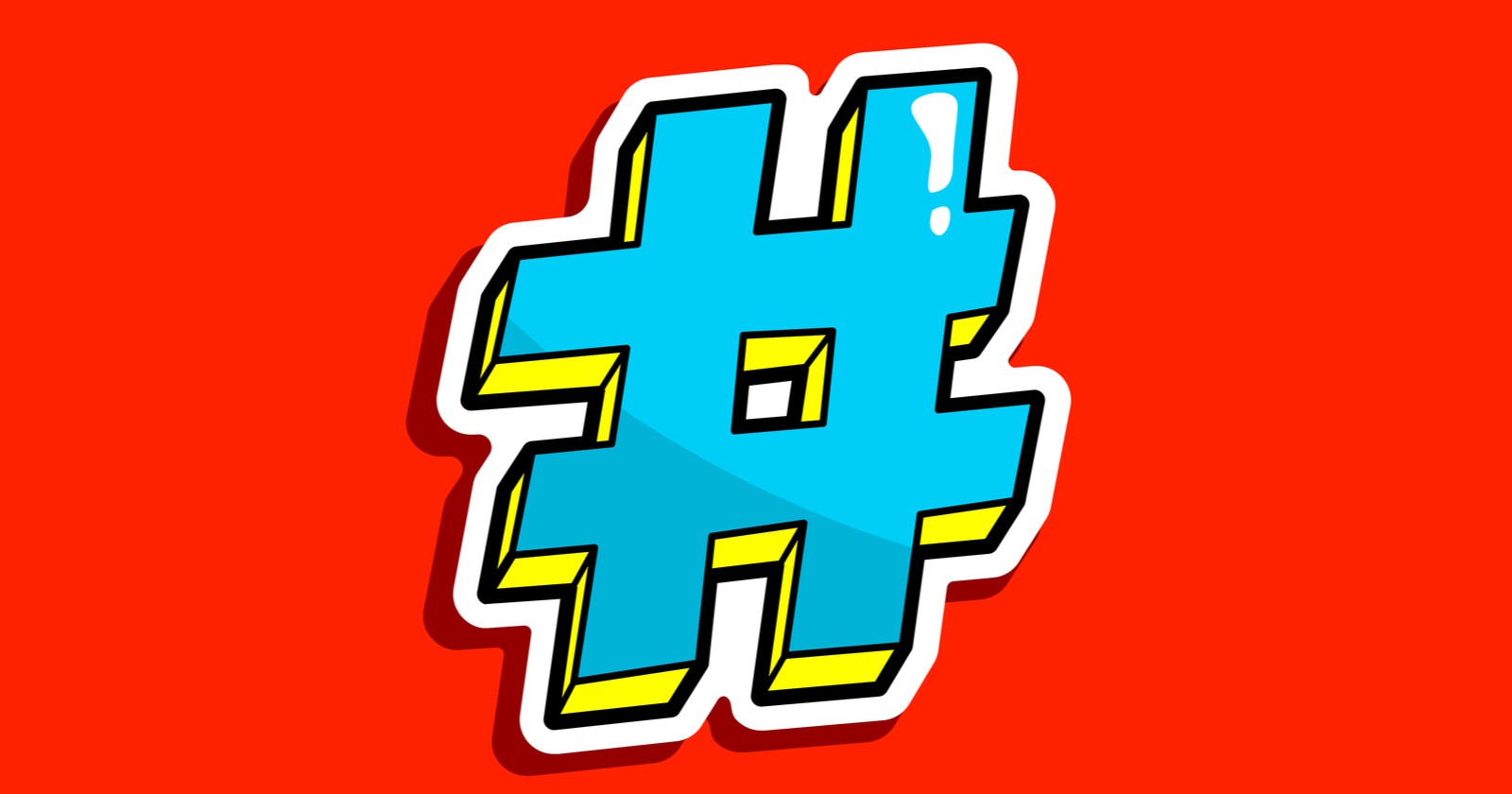The new app is called watchGPT and as I tipped off already, it gives you access to ChatGPT from your Apple Watch. Now the $10,000 question (or more accurately the $3.99 question, as that is the one-time cost of the app) is why having ChatGPT on your wrist is remotely necessary, so let’s dive into what exactly the app can do.
NEWS
Your Simple Guide to Twitter #Hashtags

There’s no doubt Twitter has changed the world we live in.
From its launch in July 2006 to its current state 13 years later, the microblogging website has become the ultimate news source, outreach platform, meme supplier, political soapbox, and so, so much more to so many people.
One of the many results of Twitter and its growing popularity was the rise of the hashtag.
Twitter infamously helped create the hashtag in 2007, first used by Chris Messina, which changed not just Twitter, but all of social media – and much of the world around it – in a big way.
What Are Hashtags?
A hashtag is a keyword index tool written with a #, or the pound symbol, at the beginning of a series of space-less keyword sets to refer to a specific topic, idea, or trend.
Hashtags are metadata tags consisting of letters and numbers – excluding spaces and punctuation – that categorize keywords and ideas (typically on social media platforms, like Twitter) by turning them into clickable phrases that are indexed with other, related tweets.
After debuting on Twitter thanks to Messina, hashtags flourished, first on Twitter, then on other social media platforms like Instagram, Facebook, and even business-oriented LinkedIn.
Hashtags have become a staple on most social media platforms and are embedded in the everyday fabric of social media.
And, thankfully, they’ve made categorization in a world of data overload easier than ever before.
How to Use Hashtags
Hashtags help categorize content among a plethora of information, thus making it easier than ever before to find and sort specific bits of information as they are published across Twitter.
It has become a legitimate source for breaking news, official statements, campaign launches, and even jarring photos and videos that have led to arrests and accusations, as well as other unexpected, unprecedented, and unbelievable interactions.
When using hashtags – either ones that are already trending or trying to kickstart a new one for a specific reason, campaign or idea – there are basic guidelines to using the right one, at the right time, with the right content. This will limit the potential for unintentional blowback, and later, damage control.
Creating a new hashtag and hopping on an existing one are drastically different moves and need to be handled as such. But they’re both helpful and are skills all quality social media marketers (and Twitter users) should understand.
Creating Hashtags
Creating a hashtag can be tricky.
Like most “viral” content on the web, some of the strangest ones will find a way to break through the surface and become a multi-day Twitter trend.
Others will fall to the wayside with very little effort.
Even the best hashtags benefit from influencer piggybacking, overall timing, and general luck to becoming a common trend on Twitter.
In addition to those aspects, you should follow a few other rules when creating a new hashtag if you want it catch on and become popular.
The three most important rules for creating hashtags are:
Keep It Simple
Keeping it simple is the most important aspect when it comes to creating a hashtag.
If it’s too complicated or elaborate, it will likely not catch on.
It also can’t be so vague that it’s impossible to separate it from other, unrelated hashtags with similar keywords or ideas.
Keep It Memorable
Clever hashtags tend to get legs easier than ones that are not.
If it’s witty and easy to remember, not only will the hashtag likely catch on and be used, but it will also likely have a longer shelf life than a hashtag that is not that memorable.
Give It the ‘Common Sense Check’
This is just as critical as the first two rules for creating hashtags, if not more.
Does the hashtag you’re trying to create make sense?
Can it be confused with another topic or hashtag that has nothing to do with your goal?
Most of all, does it offend, confuse, or lean toward the idea that this isn’t the best hashtag for your unique messaging?
A simple common sense check should help direct you as to whether your newly developed hashtag is going to be a winner or if it’s danger looming.
Using Existing Hashtags
When using hashtags that are already being used by others on the platform, there are some important rules to consider as well, but they are a bit different than those for creating new hashtags.
The three most important rules for using hashtags:
Research the Hashtag Before Adopting It
It may not mean what you think it means.
Your first step to ensuring it is the hashtag you’re looking for is to research it; look at other tweets using the hashtag and make sure they are in line with your thinking.
Too many times, users miss the mark with this one and adopt a hashtag that really means something completely different than what they intend.
Just ask DiGiorno’s Pizza about #WhyIStayed.
Make Sure It’s Relevant
Once you know what it means, make sure it makes sense to use for your messaging. Miss the mark and suffer the consequences.
Be Clever
Be sure to use your wit and personality and put your brand/personal spin on it.
Remember, the right hashtag has been used hundreds or thousands of times before you. This is the chance for you to stand out in a crowded room. Do it!
The biggest aspect of this to realize and remember is that, if hashtags are used incorrectly, it could come back to hurt the brand.
Being associated with a poor user experience is a quick and easy way to lose followers, fans, and even customers.
Potential Hashtag Nightmares
Just like anything else on the internet, there are people who will try to manipulate the system to gain an edge by doing less than others.
When it comes to hashtags, lazy (and bad) marketers will piggyback on popular and trending hashtags to gain increased visibility, sometimes compromising the integrity of the hashtag if misleading tweets aren’t filtered out.
These piggy-backers are rarely, if ever, rewarded. And brands that try it only suffer the backlash of the public, then the history books (i.e., American Apparel’s Hurricane Sandy Sale and other piggybacking disasters).
Like most things in the digital marketing realm, make sure what you’re doing is ethical and sensible. It’s unlikely you’d be penalized for that.
When to Use Hashtags
Hashtags have a time and place to be used, and it can be in every tweet a brand publishes.
It also doesn’t need to be, either.
Be genuine in your messaging and use hashtags to help categorize information, not to manipulate or deceive. Customers will remember it and they know what they want.
Why Use Hashtags
Simply put, hashtags improve your messages’ general visibility on Twitter (typically).
In addition to the increased organic visibility, hashtag users also tend to see increased engagement on the platform, increased brand awareness, and increased customer feedback, among other things, when effectively (and properly) using hashtags – all of which result in increased visibility.
Facebook Faces Yet Another Outage: Platform Encounters Technical Issues Again

Uppdated: It seems that today’s issues with Facebook haven’t affected as many users as the last time. A smaller group of people appears to be impacted this time around, which is a relief compared to the larger incident before. Nevertheless, it’s still frustrating for those affected, and hopefully, the issues will be resolved soon by the Facebook team.
Facebook had another problem today (March 20, 2024). According to Downdetector, a website that shows when other websites are not working, many people had trouble using Facebook.
This isn’t the first time Facebook has had issues. Just a little while ago, there was another problem that stopped people from using the site. Today, when people tried to use Facebook, it didn’t work like it should. People couldn’t see their friends’ posts, and sometimes the website wouldn’t even load.
Downdetector, which watches out for problems on websites, showed that lots of people were having trouble with Facebook. People from all over the world said they couldn’t use the site, and they were not happy about it.
When websites like Facebook have problems, it affects a lot of people. It’s not just about not being able to see posts or chat with friends. It can also impact businesses that use Facebook to reach customers.
Since Facebook owns Messenger and Instagram, the problems with Facebook also meant that people had trouble using these apps. It made the situation even more frustrating for many users, who rely on these apps to stay connected with others.
During this recent problem, one thing is obvious: the internet is always changing, and even big websites like Facebook can have problems. While people wait for Facebook to fix the issue, it shows us how easily things online can go wrong. It’s a good reminder that we should have backup plans for staying connected online, just in case something like this happens again.
NEWS
We asked ChatGPT what will be Google (GOOG) stock price for 2030

Investors who have invested in Alphabet Inc. (NASDAQ: GOOG) stock have reaped significant benefits from the company’s robust financial performance over the last five years. Google’s dominance in the online advertising market has been a key driver of the company’s consistent revenue growth and impressive profit margins.
In addition, Google has expanded its operations into related fields such as cloud computing and artificial intelligence. These areas show great promise as future growth drivers, making them increasingly attractive to investors. Notably, Alphabet’s stock price has been rising due to investor interest in the company’s recent initiatives in the fast-developing field of artificial intelligence (AI), adding generative AI features to Gmail and Google Docs.
However, when it comes to predicting the future pricing of a corporation like Google, there are many factors to consider. With this in mind, Finbold turned to the artificial intelligence tool ChatGPT to suggest a likely pricing range for GOOG stock by 2030. Although the tool was unable to give a definitive price range, it did note the following:
“Over the long term, Google has a track record of strong financial performance and has shown an ability to adapt to changing market conditions. As such, it’s reasonable to expect that Google’s stock price may continue to appreciate over time.”
GOOG stock price prediction
While attempting to estimate the price range of future transactions, it is essential to consider a variety of measures in addition to the AI chat tool, which includes deep learning algorithms and stock market experts.
Finbold collected forecasts provided by CoinPriceForecast, a finance prediction tool that utilizes machine self-learning technology, to anticipate Google stock price by the end of 2030 to compare with ChatGPT’s projection.
According to the most recent long-term estimate, which Finbold obtained on March 20, the price of Google will rise beyond $200 in 2030 and touch $247 by the end of the year, which would indicate a 141% gain from today to the end of the year.
Google has been assigned a recommendation of ‘strong buy’ by the majority of analysts working on Wall Street for a more near-term time frame. Significantly, 36 analysts of the 48 have recommended a “strong buy,” while seven people have advocated a “buy.” The remaining five analysts had given a ‘hold’ rating.

The average price projection for Alphabet stock over the last three months has been $125.32; this objective represents a 22.31% upside from its current price. It’s interesting to note that the maximum price forecast for the next year is $160, representing a gain of 56.16% from the stock’s current price of $102.46.
While the outlook for Google stock may be positive, it’s important to keep in mind that some potential challenges and risks could impact its performance, including competition from ChatGPT itself, which could affect Google’s price.
Disclaimer: The content on this site should not be considered investment advice. Investing is speculative. When investing, your capital is at risk.
NEWS
This Apple Watch app brings ChatGPT to your wrist — here’s why you want it

ChatGPT feels like it is everywhere at the moment; the AI-powered tool is rapidly starting to feel like internet connected home devices where you are left wondering if your flower pot really needed Bluetooth. However, after hearing about a new Apple Watch app that brings ChatGPT to your favorite wrist computer, I’m actually convinced this one is worth checking out.
-

 WORDPRESS6 days ago
WORDPRESS6 days agoTurkish startup ikas attracts $20M for its e-commerce platform designed for small businesses
-

 PPC7 days ago
PPC7 days ago31 Ready-to-Go Mother’s Day Messages for Social Media, Email, & More
-

 PPC6 days ago
PPC6 days agoA History of Google AdWords and Google Ads: Revolutionizing Digital Advertising & Marketing Since 2000
-

 MARKETING5 days ago
MARKETING5 days agoRoundel Media Studio: What to Expect From Target’s New Self-Service Platform
-

 SEO5 days ago
SEO5 days agoGoogle Limits News Links In California Over Proposed ‘Link Tax’ Law
-

 MARKETING6 days ago
MARKETING6 days agoUnlocking the Power of AI Transcription for Enhanced Content Marketing Strategies
-

 SEARCHENGINES6 days ago
SEARCHENGINES6 days agoGoogle Search Results Can Be Harmful & Dangerous In Some Cases
-
SEARCHENGINES5 days ago
Daily Search Forum Recap: April 12, 2024












